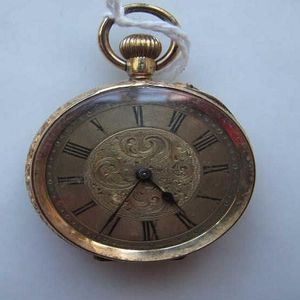Daniel Quare Silver and Tortoiseshell Verge Watch
You must be a subscriber, and be logged in to view price and dealer details.
Subscribe Now to view actual auction price for this item
When you subscribe, you have the option of setting the currency in which to display prices to $Au, $US, $NZ or Stg.
- Pique Work - A decorative technique used on jewellery and small decorative objects in which designs are created by inlaying small gold or silver studs and stips into tortoiseshell. The art reached its highest point in 17th- and 18th-century France, particularly for the decoration of small tortoiseshell articles such as combs, patch boxes, and snuffboxes.
- Foliate - Decorated with leaves or leaf-like forms.
- Tortoiseshell - Tortoiseshell is a translucent material that comes from the horny carapace of a certain types of turtles, including the hawksbill turtle. It is often therefore mounted on a colour underground - often red - or inlaid with gold or silver thread, as seen in Boulle furniture.
The texture and colour nuances of the material are extremely important. Heated tortoiseshell can easily be formed into various shapes. Like other natural materials, tortoiseshell becomes more beautiful with use. In a time before plastic, tortoiseshell was widely used for small objects such as combs and powder compacts.
In 1973, the trade of tortoiseshell worldwide was banned under CITES (The Convention on International Trade in Endangered Species). Prior to importing or exporting items containing tortoiseshell a CITES permit must be obtained. Tortoiseshell items cannot be traded on Ebay.
"Faux tortoiseshell", another case of man initiating nature, is made from old-style plastics such as celluloid and cellulos and is coloured with red, yellow and brown spots to imitate the genuine article. It is commonly used in glasses frames, musical instruments and costume jewellery. - Fusee - The fusee movement was used in clocks and pocket watches from the mid 17th century. The fusee is a cone shaped drum within the works that is linked to the barrel of the spring, usually by a length of chain.
As the mainspring loses its tension over time, the cone shaped barrel compensates for this by increasing the tension, by pulling the mainspring tighter, thus ensuring the time remains constant.
Use of the fusee in clocks was superseded by the "going barrel" in the mid 19th century and for pocket watches at the beginning of the 19th century.
The fusee continued to be used in marine chronometers until the 1970s. - Verge Escapement - A verge escapement is an early mechanical escapement used in clocks and other timekeeping devices. It is an early form of the escapement mechanism, which is used to regulate the movement of the hands of a clock or watch. The verge escapement consists of a vertical shaft called the verge, which is mounted on the clock's main plate. Attached to the verge are two pallets, which engage with the teeth of the escape wheel. As the escape wheel turns, the pallets alternately lock and release it, allowing the movement of the clock to be regulated. The verge escapement was widely used in early mechanical clocks, but it was eventually replaced by the more accurate and reliable anchor escapement.
- Bezel - On a clock or watch, the bezel is the metal frame into which the watch or clock glass is fitted. In clocks, the bezel may include a hinge and a flange, in effect a door to the face of the clock. In jewellery the bezel is a band of metal with a projecting lip that holds the gemstone in its setting.
- Movement - The technical name for the workings of a clock or watch, and does not include the dial or case.
- Circa - A Latin term meaning 'about', often used in the antique trade to give an approximate date for the piece, usually considered to be five years on either side of the circa year. Thus, circa 1900 means the piece was made about 1900, probably between 1895 and 1905. The expression is sometimes abbreviated to c.1900.
This item has been included into following indexes:
- clocks, material or decoration - tortoiseshell cased 106
-
pocket watches, case type
- open face, silver case 570
- pair cased 165
- silver case 905
- pocket watches, features - repeater / repeating 107
- Quare, Daniel (England) - clocks, maker or retailer 4
Visually similar items

Antique 18kt gold ladies pocket watch works

Sterling silver open face key wind pocket watch by G Mathey 26359, fancy coloured and white enamel dial

Paul Beauvais London. A silver quarter repeating verge watch with alarm mvt 539 English circa 1730, gilt full plate movement signed and numbered Paul Beauvais, London no. 539, verge fusee escapement, pierced floral engraved balance cock, a mask at the neck

18ct open face fob watch fancy gilt dial and engraved back cover, lever wind Check chain
